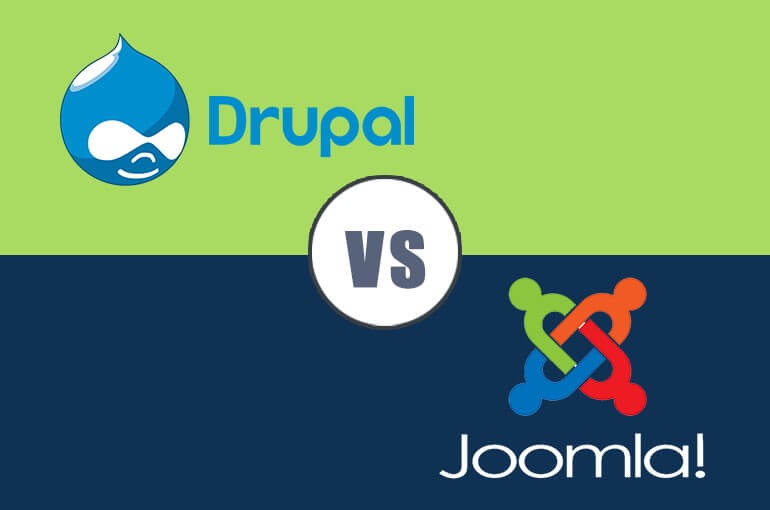Drupal vs Joomla: Which One Is the Best CMS Platform
Have you ever heard about Drupal and Joomla? They are the most popular CMS platforms in the world today, which enable you to build and manage content on websites. All of them are also open source and thus free to use. Drupal and Joomla are both created on the same purpose and functionality as a CMS platform. Now, let’s find out in detail what is CMS platform and how it works to have a clear insight about these two definitions.
CMS platform – what is it?
CMS, another call for Content Management System, is a software to manage the creation and editing of digital content with basic programming knowledge. CMS provides an intuitive web-based interface for users to handle every aspect of the website such as creating content, format text, adding photos and videos, designing websites, searching queries, and so on.
The main functions of CMS are:
- Create and store content
- Edit content
- Transfer in and share content
- Search and decentralize users
How it works:
Without CMS, you will need to use many different programming languages to create your website as well as manually upload content to the server to ensure the workflow of the two website components: the external interface and the internal management (often called front-end and back-end).
- Front-end is the part that visitors will see when accessing through the browser: articles, images, videos on the website. The text is displayed in a standard markup language called HTML, the design to create a harmonious and beautiful layout of the site is due to the use of CSS and JavaScript.
- The back end includes the database and the website’s functionality. Content is saved to the database and pushed from the back-end when a visitor requests a web page. Back-end functionality is written in many different programming languages, like PHP, Python, JavaScript, etc.
With CMS, you don’t need to write code for front-end and back-end. This application creates a user-friendly system (managed by interface) that runs directly in the browser. A content management system will help you use the content editor to create articles, websites, web stores, and publish any online content.
Drupal vs Joomla – How do they differ?
Drupal, the third popular CMS platform after WordPress and Joomla, was released in 2001 by Dries Buytaert. It focuses on standard features including reliable performance, strong security, and reliable customizability. More than 4% of CMS based websites on the web are created by using this platform, ranging on various industries: government agencies, eCommerce, blogging, education and many others.
Joomla, the second popular platform after WordPress, was first released in 2005 by an Australian Company. Joomla seems the youngest at the established age, however, it has already earned lots of public attraction with an amazing building website platform with the use of 7% of CMS-based websites including business, educational, entertainment, government, health, and technology. Its features lie somewhere between WordPress and Drupal with regards to user-friendliness and customizability.
Drupal and Joomla are considered as the two effective CMS platforms to boost website performance. However, they also have some distinct differences in features and functionality according to the various conditions of the users. Here are 5 criteria you should use to have a full comparison of these two CMS, before making a decision:
- Beginner friendliness (dashboard)
- Site management(setting)
- Customizability (design templates)
- Web security
- Team collaboration
Now, let’s compare them in detail as the following.
#1 Beginner friendliness
Drupal
When first entering on Dashboard, the interface look quite simple and clean with eight menus on the left sidebar. Once you dig in, there’s a staggering number of settings you can play with:
- Content: Add articles and basic pages.
- Structure: Add, edit and manage various elements like Block layout, Comment types, Contact forms, Content types, menus etc.
- Appearance: Customize Drupal themes.
- Extend: Drupal modules work as the plugins to WordPress. They add functionality to a Drupal website. You can see the list of installed modules, install new modules and manage them from ‘Extend menu’.
- Configuration: It works as administrator panel where can find account settings, basic site settings, media settings, Search engine indexing settings etc.
- People: Add new users, assign status, role, and permission to the users.
- Reports: Check out available updates, recent log messages, field list, status report and more.
- Help: Few steps on getting started with Drupal.

As the first step of customizing the site, go to ‘Appearance‘ menu, you’ll see a theme control page like in the image below including two themes installed by default and option to ‘install a new theme’.

Joomla
On Joomla dashboard, it strikes an excellent balance between offering a wealth of features and making those features easy to use by providing a graphic interface to add and manage articles, media, menus, extensions and change settings.

On the Joomla Control Panel comprises six menus, here are the brief description:
- Content: Content menu has four other sections New Article, Articles, Categories and Media. Structure: Add and configure menus and modules.
- Users: Add and manage user groups, access levels, user notes and more.
- Configuration: It is the most significant menu in the Joomla control panel. It has ‘Global Configuration’ for the site, the option to ‘templates’ and ‘language’ settings.
- Extensions: Install new extensions and manage them.
- Maintenance: Show the duration of Joomla core and the installed extensions.
There are a lot of options to play with here and very easy to figure them out. For example, when clicking on the Articles tab, you’ll see a list of all your published content, viewed in nice layout and logical arrangement.

#2 Site management
Drupal
In this extent, Drupal provides plenty of advanced management options, including built-in error. It also stores the queries people look for on your website:

Joomla
Joomla also offer a lot of settings that can be customized such as tweaking the site’s SEO, enabling CAPTCHAs, configuring your caching settings, setting up multiple languages.

Overall, both Drupal and Joomla provide all the basics that a professional site need to handle. Drupal, however, invole much more specific configuration settings. It can be an advantage if this isn’t your first website building project.
#3 Customizability
Drupal
Drupal is highly recommended for its flexibility and extensible. Also, it has a powerful core software that is security proven and has enhanced performance. In order to add functionalities, you have to install modules. The design of a Drupal site is based on the theme.

Drupal has a huge collection of free and premium themes:
- The official Drupal theme repository has more than 2000 templates, you can visit here to download more official themes
- Drupal’s premium theme collection has more than 450 templates, visit here to purchase, download and update your Drupal site.

However, there is a minus point of Drupal for offering a less appropriate option for beginners. In this feature, Drupal is only a suitable platform for people who are willing to build a professional website with enough coding skills or have plenty of time for self-learning.
Joomla
Just like Drupal, Joomla also uses templates for design control. However, Joomla offers comparatively fewer options than Drupal. Specially, it has NOOfficial Template Directory like Drupal. You must go to the third parties theme makers’ websites for Joomla themes.
If you want a paid template, you can go the theme marketplace ‘ThemeForest’. There are more than 950 Premium Joomla Templates at ThemeForest.

directory, it has a feature-rich extension directory. There are more than 7500 Official Extensions for free and paid in the official Joomla extension directory. One good point about using this platform is direct access to these extensions right from the Joomla dashboard.

In short, Drupal is a great platform with unlimited design possibilities. It is the best choice for developers with high techies to build a professional website as their will, and of course it is not the one for those who don’t want to spend so much time for learning curve. And Joomla has a fewer template design options than Drupal but instead, in every option, it provides plenty enough features for a complete website. This is the perfect choice for those who want to work in a simple framework and finish the website in a short duration.
#4 Security
Drupal
Security is a strong advantage of Drupal, as a very safe CMS. Whenever a vulnerability is discovered, it will be quickly recognized on the official website. Patches will instantly follow by. For that, Drupal offers extensions to make your site safer. For example, there is a module that creates security reports inside the back-end. This helps you spot and deal with any site weaknesses.

Joomla
Joomla takes seriously on ensuring the safety of your site on the user. It is noticed that the application of the security is up to the individual user. That means the security system is not automatically set up, you have to do it yourself from back-end. Hence, in Joomla documentation, there is a security checklist covering from hosting over setup and administration to recovering from a hack.

#5 Team Collaboration
Drupal
Drupal also offers collaboration tools for:
- Making your own right and control permissions for each user individually.
- A revision tool to work on content together with other authors.
Joomla
The Joomla platform comes with access levels and permission. Like WordPress, you can also see your content’s history to track changes over time. In addition, there are many extensions for task management and workflow improvements as well as plugins to control access levels for other users.
Which one is the best CMS platform?
With Drupal,
At the first sight, Drupal seems to be difficult to apply due to its learning curve. However, for developers with efficient programming skill, it will be the best fit for them. When you look into the detail, there’s a lot of benefits to mention about this CMS such as:
- A ton of built-in site management options.
- Access to thousands of modules and themes.
- The ability to customize every aspect of your experience.
- A lightweight platform that scales well.
With Joomla,
Joomla is undoubtedly a strong CMS platform due to its functionality. It provides a full collection of features for a complete website, which helps those with little coding knowledge to build their website with a simple workflow and in a short of time. Here’s the detail of its support:
- Great balance between ease of use and complexity of functionality.
- Access to a lot of customization options.
- Built-in performance and SEO features.
Both Drupal and Joomla are great CMS platforms that create and manage content on websites professionally, supported with programming capabilities. Each one has its own significantly different features, which serve different kinds of users, for different purposes. In addition to being easy to use, they also very easy to customize. Pre-made themes, popular plugins, extensions, you can design and choose features that best suit your needs. There are many practical cases that have proven this, most of them are individuals, startups, they used CMS to turn the website from a basic page to creating famous brands online.
Now that you know what CMS is, how to make use of Drupal and Joomla, how they differ in the way of serving, you should have own comparison to find out the best match to your business demands. Wish you have a great choice!









